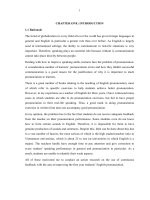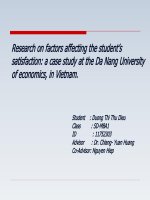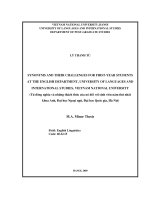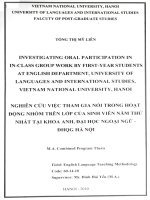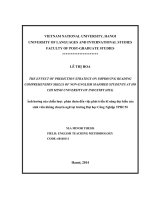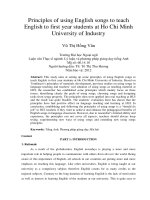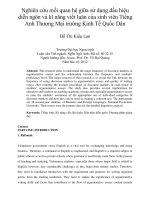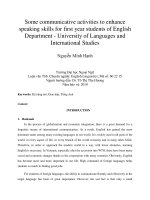synonyms and their challenges for first-year students at the english department, university of languages and international studies = từ đồng nghĩa và những thách thức của nó đối với sinh viên
Bạn đang xem bản rút gọn của tài liệu. Xem và tải ngay bản đầy đủ của tài liệu tại đây (595.25 KB, 47 trang )
Vietnam national university, Hanoi
University of languages and international studies
Department of post-graduate studies
Lý thanh tú
Synonyms and their challenges for first-year students
at the English department, university of languages and
international studies, Vietnam national university
(Từ đồng nghĩa và những thách thức của nó đối với sinh viên năm thứ nhất
khoa Anh, Đại học Ngoại ngữ, Đại học Quốc gia, Hà Nội)
M.A. Minor Thesis
Field: English Linguistics
Code: 60.22.15
HANOI, 2009
Vietnam national university, Hanoi
University of languages and international studies
Department of post-graduate studies
Lý thanh tú
Synonyms and their challenges for first-year students
at the English department, university of languages and
international studies, Vietnam national university
(Từ đồng nghĩa và những thách thức của nó đối với sinh viên năm thứ nhất
khoa Anh, Đại học Ngoại ngữ, Đại học Quốc gia, Hà Nội)
M.A. Minor Thesis
Field: English Linguistics
Code: 60.22.15
Supervisor: Dr. Hà Cẩm Tâm
HANOI, 2009
iii
Table of contents
Acknowledgement
i
Abstract
ii
Table of contents
iii
introduction
1
1. Rationale of the study…………………………………………………………
1
2. Scope of the study………………………………………………………………
2
3. Aims of the study………………………………………………………………
3
4. Organization of the study……………………………………………………….
3
DEVELOPMENT
4
Chapter 1: literature review
4
1.1. Overview of synonyms………………………………………………………
4
1.1.1. Synonymy as a sense relation……………………………………………
4
1.1.2. Definition of synonyms ……………………………………………………
4
1.1.3. Characteristics of synonyms ………………………………………………
5
1.1.4. Classification of synonyms………………………………………………
6
1.1.4.1. Absolute synonyms …………………………………………………
6
1.1.4.2. Non-absolute synonyms………………………………………………
1.1.4.3.
1.2. Factors distinguishing synonyms …………………………………………….
7
1.2.1. Connotation………………………………………………………………
7
1.2.2. Formality of the context……………………………………………………
9
1.2.3. Collocation…………………………………………………………………
10
1.2.4. Denotation………………………………………………………………….
12
1.3. Componential analysis………………………………………………………
14
Chapter 2: methodology
16
2.1. Research design………………………………………………………………
16
2.1.1. Research questions…………………………………………………………
16
iv
2.1.2. Data collection instruments………………………………………………
16
2.1.3. Informants………………………………………………………………….
17
2.1.4. Procedures………………………………………………………………….
17
2.2. Analytical framework…………………………………………………………
17
Chapter 3: Data analysis and discussions
3.1. Discussion of the results of the test. …………………………………………
19
3.1.1. Result of exercise 1…………………………………………………
19
3.1.2. Result of exercise 2…………………………………………………
25
3.1.3. Result of exercise 3…………………………………………………
28
3.1.4. Result of exercise 4…………………………………………………
30
3.2. Major findings…………………………………………………………………
33
Conclusion
35
1. Concluding remarks…………………………………………………………
35
2. Implications of the study results………………………………………………
36
3. Suggestions for further research……………………………………………
38
1
introduction
1. Rationale of the study:
Synonyms do exist in almost every language, including English. English, as Howard
Jackson states, is a language rich in pairs of synonyms. These pairs (or groups) of synonyms
give us various choices when we want to convey one and the same idea. They make a
language flexible and varied. However, to choose the appropriate word among a group of
synonyms for a specific situation is not simple. If we can do this, we may feel absolutely
satisfied because we have expressed ourselves not only correctly but also lively and
emotionally. We can create a mental picture for the reader by using words that are specific and
accurate. Thank to this, our utterances or sentences are very persuasive and appealing to
readers or listeners. On the contrary, if the word we use is not suitable, we may feel
embarrassed and even uneasy.
This fact proves one thing that pairs or groups of synonyms are not substitutable in
every situation. Two words may be synonymous and equally appropriate for one context, but
not so in another. There are some underlying factors that make them different from one
another. Even native speakers, who are aware of these factors, sometimes find it hard to
express themselves by not being able to choose the most suitable word. An example in
Vietnamese is that when a young girl wore a new orange T- shirt with the pattern of a butterfly
on it, her mother liked it very much and wanted to pay a compliment to her. However, she
happened to find no words to say what she wanted to. Her mind seemed to be empty, and she
felt very confused. She said to her daughter that “Thoa hôm nay có cái áo sặc sỡ thế!” Yet she
was completely dissatisfied with her word choice because in Vietnamese “sặc sỡ” has a
neutral, or sometimes rather negative sense, whereas her comment on her daughter‟s T- shirt
was entirely positive. After a while, a friend of the girl came and saw the T- shirt, she
exclaimed: “¤i, chị có cái áo thật là rực rỡ!” Then the girl‟s mother appeared to be released
from her uneasiness and confusion now that she found the key to her problem of vocabulary.
“Rực rỡ” is exactly the word she wanted to use for her compliment, and that word gives an
extremely different impression of how she felt about the T- shirt.
2
Therefore, using synonyms flexibly and effectively is really a challenge for students
learning a foreign language.
First year students at English Department, College of Foreign Languages, Vietnam
National University, have not learnt language theory, so a majority of them are not highly
aware of the factors underlying a pair or a group of synonyms. As a result, they make a lot of
errors in using synonyms. Nevertheless, these errors can be restricted and corrected if the
students are warned about those factors.
That is why this study is carried out, to investigate the factors underlying the use of
synonyms, and to help first year students to improve their use of synonyms in writing.
2. Scope of the study:
This study is confined to English synonyms only. It is not a contrastive analysis of
synonyms, so Vietnamese synonyms are not mentioned. They are just given as illustrations for
the universal properties of synonyms. Even within English synonyms, only several groups are
investigated owing to the fact that the number of English synonyms is huge, and certainly a
minor research can hardly cover all of them.
Once the study is developed, it can be seen that there are several factors underlying the
use of synonyms; however, not all of these factors make synonyms become challenging to
students, so only the factors that cause students to make errors are discussed in details. The
other factors are just listed for reference.
Although students at higher levels of English still make mistakes in using synonyms,
only first year students are taken into consideration as they are appropriate subjects for the
purpose of the study.
3. Aims of the study:
This study is carried out to serve three major purposes:
- To conduct an investigation into different aspects of English synonyms.
- To address the issue of using some specific groups of synonyms of first year students
in English Department, College of Foreign Languages, Vietnam National University.
This is done by making the students to do some tests. Then their errors in the tests are
picked up and examined for causes and sources
3
- To provide some recommendations for preventative and curative measures to help
improve first year students‟ use of synonyms.
4. Organization of the study:
There are three main parts in this thesis. The first part is INTRODUCTION in which
the rationale, scope, aims, and design of the study are presented so that readers can have a
general view of the thesis.
The second part of the thesis is DEVELOPMENT. This part is sub-divided into three
main chapters. The first chapter deals with theoretical background and review of literature. In
this chapter, all the basic knowledge of synonyms, namely definition, characteristics, and
classification are reviewed. Chapter 2 is about the methodology of the study. It describes the
research questions, informants, data collection instruments, and analytical framework. Chapter
3, the backbone of the thesis, deals with data analysis and discussions. This chapter mainly
presents the errors in using synonyms by first year students and discusses their causes as well
as suggests preventative and curative measures. Through this last chapter, teachers and
students may find useful methods to apply in their real teaching and learning.
The CONCLUSION part presents concluding remarks, implications for teaching and
learning synonyms, and suggestions for further research.
4
development
Chapter 1: literature review
The knowledge of synonyms, factors distinguishing them, and the skill of
componential analysis are required for identifying and analyzing first year students‟ errors in
using synonyms. Therefore, this chapter deals with the basic concepts and ideas to set the
theoretical background for analyses which will be carried out later in this study.
There are different definitions and discussions on synonyms from various semanticists.
Some representatives are John Lyon, W. Kreidler, Michael McCarthy, Norbert Schmitt, etc.
Their points of view on synonyms will be discussed and compared to establish a
comprehensible and rich theoretical background that serves the purpose of the thesis.
1.1. Overview of synonyms:
1.1.1 Synonymy - a sense relation:
Sense relation is an internal meaning relation that holds between words within the
vocabulary system of the language. In other words, it is the paradigmatic relation, the relation
between different words that might have been chosen on the „vertical‟ axis. The most obvious
sense relations are those of „sameness‟, „oppositeness‟, and „including‟. Such terms as
synonymy, antonymy, and hyponymy are used to refer to these relations respectively.
So synonymy is a type of sense relation or lexical relation, a subject of semantics. It is
the relation of sameness that holds between two or more words. Therefore, the matter of
synonymy and the use of synonyms are mentioned in almost all books on semantics and
vocabulary.
1.1.2. Definition of synonyms:
Many well- known linguists have given their own definitions of synonyms, mainly in
their books of semantics or vocabulary. Though the ideas are quite similar, they are expressed
in different ways.
Charles W. Kreidler (1998:97) writes about synonyms in his book Introducing English
semantics. According to him, synonymy is an instance of mutual entailment, and synonyms
are instances of mutual hyponymy. He takes the following example:
(a) Jack is a seaman
5
(b) Jack is a sailor
Because the truth of (a) entails the truth of (b) and vice versa, and also the falsity of (a)
entails the falsity of (b) and vice versa, seaman and sailor are synonyms.
Linguistic semantics with a famous representative, John Lyon, defines synonyms as
“expressions with the same meaning”. Similarly, Michael McCarthy (1997) says “synonymy
means that two or more words have the same meaning.” He takes series of examples as begin
and start, sofa and settee, below, beneath and under(neath), etc. D.A. Cruse (1986) in the
book Lexical semantics states that synonyms are pairs or groups of lexical items bearing a
special sort of semantic resemblance to one another. Howard Jackson (2000:92) also mentions
“sameness of meaning” that holds between two words when discussing synonyms.
So each linguist uses a different expression, but they all agree that synonyms are pairs or
groups of words with the same meaning. Only Lyon differs from other linguists in using the
term “expressions”. He makes clear this point by explaining that his definition does not restrict
the relation of synonymy to lexemes, so lexically simple expressions may be synonymous to
lexically complex expressions. Denying this, Kreidler (1998:98) affirms that synonyms are
typically single lexemes of the same weight. Therefore, Mr. Jenkins is our postman and Mr.
Jenkins is the person who delivers our mail may have the same meaning, but postman and the
person who delivers our mail are not synonyms.
For the purpose of this study, synonyms are confined to lexemes, but not necessarily
“single lexemes of the same weight”, and certainly they must be categorized as the same part
of speech. So, die, pass away and kick the bucket are considered members of a group of
synonyms. This will serve as a working tool in this thesis.
1.1.3. Characteristics of synonyms:
Two words are synonymous only when they are compatible with the same subjects.
For example, hard and difficult are synonyms when they are compatible with subject, so
“Integral calculus is a hard subject” also means “Integral calculus is a difficult subject”.
However, while hard chair or hard knock is familiar, there are no such things as difficult chair
and difficult knock. This is to say that synonyms have different ranges of compatibility, the
ranges overlap but they are not co-extensive.
6
Another characteristic of synonyms is that the bridging rule is not applicable for them,
i.e. the fact that A is synonymous with B and A is synonymous with C does not necessarily
means that B is synonymous with C. Thus, funny is synonymous with humorous when
compatible with story, and funny is synonymous with peculiar when compatible with feeling,
but humorous and peculiar are not synonyms.
Funny story = humorous story
} humorous # peculiar
Funny feeling = peculiar feeling
1.1.4. Classification of synonyms:
1.1.4.1. Absolute synonyms:
“Absolute synonyms” is the term John Lyon used for pairs or groups of synonyms that
can be substituted for one another in any given context, whereas Jackson (2000) would rather
call this „strict synonyms‟. In this research, these two terms are used interchangeably. Lyon
establishes a set of three criteria to assess whether a pair of synonyms is absolute or not.
(i) all their meanings are identical
(ii) they are synonymous in all contexts (their collocational ranges are identical)
(iii) they are semantically equivalent (their meaning or meanings are identical) on
all dimensions of meaning, descriptive or non-descriptive)
More simply, Jackson states that the choice between strict synonyms would have no
effect on the meaning, style or connotation of what was being said or written. Cruse also
makes a short explanation of absolute synonyms with the condition that all their contextual
relations are identical.
Although many linguists mention absolute synonyms and classified them as one type
of synonyms, they all agree that this type of synonyms is really rare. Some linguists even
argue that absolute synonyms do not exist. If they do, it is only when semantic change is
taking place. This means that when two words appear to become strict synonyms, either of
them will change its meaning or fallen out of use. Jackson takes sky and heaven as an
example. At first, these two words denoted both the physical firmament and the spiritual realm
of God and the angels. Then sky came to denote just the physical, and heaven just the spiritual.
7
The scarcity of absolute synonyms is justified with different words as “uneconomical”,
“unnecessarily redundant”, “wasteful”, “luxurious”, etc. We do not need a completely free
choice between two words for a particular context because we can well do it with only one.
1.1.4.2. Non- absolute synonyms:
Non-absolute synonyms (or partial synonyms) should be distinguished from near
synonyms, as Lyon proposed.
Near synonyms are words which are more or less similar, but not identical in meaning.
Some examples are mist and fog, stream and brook, dive and plunge, ask and beg, etc.
Partial synonyms are synonyms which fail to satisfy all the three conditions for
absolute synonyms. The failure of any of those three conditions makes a pair of synonyms
non-absolute. Take big and large as an example. They are partial synonyms because not all
their meanings are identical. Besides, they have different collocational ranges. Big can
collocate with house, sister, mistake, etc. Large can also collocate with house and sister but it
does not collocate with mistake.
Another classification of synonyms makes it easier for us to follow. Apart from
absolute synonyms, there are five other types, but only three of them are mentioned here
because the other two types do not serve the aim of this thesis:
Semantic synonyms are synonyms which differ in denotation (like near synonyms
described above).
Stylistic synonyms are synonyms which differ in connotation. For example, while thin
is neutral, skinny is pejorative and slender is flattering.
Semantic stylistic synonyms are synonyms which differ in both denotation and
connotation. This type makes up the majority of synonyms in English.
1.2. Factors distinguishing synonyms:
As indicated in the scope of the study, there are many factors underlying the use of
synonyms, but for the purpose of the study, only the factors which cause difficulties for
freshmen at university are mentioned and investigated in this part of the research. Hence, such
factors as dialect difference (or geographical distribution) and syntactic behavior or pragmatic
value are neglected.
8
1.2.1. Connotation:
In addition to literal, dictionary meanings, words often have implied, emotional
meanings known as connotations. These connotations play an important role in the search for
the „right words‟ because they sometimes clash with the writer‟s intended meaning or view.
Distinguishing between two words that seem to mean the same but have different colors and
shapes and suggestions, this is essential to the art of writing, and also of speaking. The
dictionary can tell you only what a word points to, it cannot tell you what it feels like.
Unspeakable in the dictionary means the same as unutterable but the former is always used to
mean something base or vile, while the latter usually means some rapturous or divine thought
or emotion.
Another example is that in the following sentence, the word pushy conflicts with the
meaning in the rest of the sentence
The pushy citizen patiently waited for his turn at the microphone before confidently
expressing his concerns about the city council’s recent decision to staff the fire station
with volunteers.
A pushy individual probably wouldn‟t have waited patiently for his turn to speak, but
rather would have barged in whenever he felt emotionally led to do so. Perhaps, a more
appropriate descriptive word for an individual who “patiently waited” before “confidently
expressing his concerns” might be assertive.
Two words may largely share a denotation, in referring to a particular entity, but they may
have divergent associative and emotive meaning. Therefore, it is very important for a writer to
choose words which have appropriate connotations; otherwise, it might cause offence to the
readers, or at least make the writer misunderstood. Moreover, connotations can help the
description become not only more exact but also more lively and vividly. Push and shove may
serve as an example here: their denotation largely overlaps, that is „forceful propulsion
forward‟; but shove connotes roughness or haste, which push does not. So “The bus was so
crowded that I was shoved forward and back again ad again” sounds more descriptive than
“The bus was so crowded that I was pushed forward and back again and again”.
9
The following table lists some group of words which have similar dictionary meanings but
are different in connotative meanings
Favorable
Neutral
Unfavorable
1.
relaxed
inactive
lazy
2.
prudent
timid
cowardly
3.
modest
shy
mousy
4.
time-tested
old
out-of-date
Favorable
Neutral
Unfavorable
5.
dignified
reserved
stiff-necked
6.
persevering
persistent
stubborn
7.
up-to-date
new
newfangled
8.
thrifty
conservative
miserly
9.
self-confident
proud
conceited
10.
inquisitive
curious
nosy
Some other examples are: (all the words on the left are neutral)
Ambiguous equivocal (deliberately)
Famous notorious (disreputably)
Hate loathe (with repugnance or disgust)
Misuse abuse (of privilege or power)
New novel (strikingly)
Obtain procure (with effort)
1.2.2. Formality of the context:
Language cannot be used in isolation from the context. When something is said or
written, vocabulary needs to be chosen carefully basing on who is saying, to whom, when,
where and why. It is the relationship between the content of a message, its sender and receiver,
10
its situation and purpose, and how it is communicated, which altogether make up register. In
terms of register, Halliday proposes three key components which restrict the selection of
vocabulary. They are field, tenor, and mode:
Field: the subject matter and purpose of a message (travel‟s brochure, etc.)
Tenor: the relationship between sender and receiver (boss to employee, friend to friend,
etc.)
Mode: the channel of communication (phone call, written report, notice, etc.)
Basing on these three components, contexts are often divided in such types as formal vs.
informal/slang/colloquial, written vs. spoken, technical vs. non-technical.
As a result, one word in a pair of synonyms may be used in a more formal context than
the other; or one of the pair may belong to slang or colloquial English, while the other is in
more general use. The level of formality you write should be determined by the expectations
of your audience and your purpose. For example, if you are writing a cover letter for a job
application or a college academic essay, you should write in a formal style. If you are writing
a letter to a friend, something personal, or even something for a humorous or special interest
magazine when informal writing is expected, you would use a more informal style. Formality
exists on a scale, from formal to semiformal, and to informal.
Formality of the context is very important in writing in the sense that if the writer writes
in a wrong style, it may cause offence or create a distance between the writer and the readers.
For instance, if the writer uses colloquial language or slang in an application form, the reader
may feel that they are offended. Consequently, the applicant is likely to be refused. On the
contrary, while writing to a close friend, if the writer uses too formal words, the reader will
think that the writer stands on ceremony with him/her, and so keeps a distance from the writer.
Following are some examples of synonym pairs, the ones on the left are usually used in
an informal or less formal context while the ones on the right in a more formal context:
Informal/ less formal
Formal
Argument
Disputation
Die
Decease
11
Informal/ less formal
Formal
Give up
Renounce
Letter
Missive
Western
Occidental
Stuff
Many
Put out
Extinguish
1.2.3. Collocation:
According to Howard Jackson (2000), collocation refers to a structural or syntagmatic
relations that a word contracts with other words occurring in the same sentence or text. It is
concerned with the meaning arising from co-occurrence, more specially to meaning arising
from predictable co-occurrence.
Two things should be marked in Jackson‟s idea. Firstly, collocation is not only about
synonyms. It is structural or syntagmatic relation held between a word and any word that can
co-occur with it in a sentence. Besides, collocation most clearly occurs in specified syntactic
relation, e.g. S + V (kettle + boil), or V + O (boil + kettle), or A + N (red + wine). These
should be called „grammatical collocation‟, in order to differentiate it from „lexical
collocation‟, which is the subject of this study.
Secondly, collocation is predictable. It is a relation of mutual expectancy or habitual
association. The occurrence of one word predicts the greater than chance likelihood that
another word will occur in the context. The statistical terms „greater than chance likelihood‟
suggest that the mutual expectancy of two words could be stronger or weaker, depending on
both the direction of expectancy and the number of alternative predictable words. For
example, between kettle and boil, the collocation from kettle to boil is stronger than that from
boil to kettle because the number of verbs that regularly co-occur with kettle is less than the
number of nouns that regularly co-occur with boil. Similarly, wreak has a stronger
collocational relation with its object nouns than does settle because wreak occur
predominantly with only two nouns (havoc and revenge) whereas settle occurs with a whole
range of nouns: dispute, argument, stomach, nerves, child, etc.
12
In agreement with H. Jackson, Michael McCarthy (1997) claims that there is a binding
force or a „marriage contract‟ between words, and some words are more firmly „married‟ to
each other than others. He takes example of blond and brown. Both can co-occur with hair,
but the relationship between blond and hair is stronger than that between brown and hair
(given blond, there is hardly anything else to think of besides hair, but given brown, we can
think of a large number of other nouns). McCarthy gives high opinion of collocation, saying
that it is fundamental in the study of vocabulary, and it deserves to be a central aspect of
vocabulary study.
An example taken from McCarthy‟s book “Vocabulary” illustrates the influence of
collocation on word choice. Some everyday words denoting size are considered to see how
they collocate with a random selection of single nouns:
Problem
Amount
Shame
Man
Large
?
v
x
v
Great
v
v
v
v
Big
v
v
v
v
Major
v
?
x
x
v= collocates ?= questionable x= does not collocate
One remarkable thing about collocation is that until relatively recently, the intuitive
method was the only one possible for lexicologists to discover it, and it is the method that is
reflected in the content of most dictionaries. Adult native speakers also have a good intuitive
knowledge of typical collocations. However, it is not a reliable method for investigating a
statistical probability, which implies a degree of accuracy. This, fortunately, have been cured
by today‟s corpora of a hundred million words. Computers scanning huge amounts of text can
confirm and augment those intuitions, or can make explicit what we use automatically in our
everyday language. Vietnamese learners, unfortunately, have not been familiar with these
corpora. The traditional way of learning still have influence on them, so they often learn just
13
the meaning of each individual word but not a lexical chunk or phrase. That is why collocation
is really challenging to them.
1.2.4. Denotation:
Denotation is the most obvious aspect of meaning, so it is the first thing people are
often concerned about when they learn or use a word. However, it is listed as the last factor in
this part because denotations of words, if learnt carefully, are not very troublesome. Therefore,
it is considered just as a minor factor in this thesis.
In fact, it is denotative meaning of words that creates the type of synonyms which John
Lyon identified as near synonyms. Near synonyms, in nature, are the synonyms whose
denotations are more or less similar but not identical. Involve and include can serve as an
example here. According to Oxford dictionary, involve means to have or include something or
somebody as a part, an element, a condition, or a result, whereas include means to have
something as part of a whole. The remarkable thing is that involve specially refers to a
situation or an event, but include does not. Thus, it should be „The accidents involved several
vehicles‟, but not „The accident included several vehicles‟.
The difficulty with denotation is often caused by the translation into L1. Obviously,
there are always lexical gaps between any two languages. As a result, a word in L2, which
does not have any exact equivalent in L1, will be at risk of being translated without being
stored its original meaning. If the learners choose the word in L1 first, and translated it into
L2, there is great likelihood that they will make mistake. For example, both remark and
evaluate can be translated into Vietnamese as „nhận xét, đánh giá‟, their denotations in
English are quite different. Remark means „to write or to say something as a comment, to
observe something‟, while the denotation of evaluate is „to assess or to form an idea of the
amount, quality, or value of somebody or something‟. Hence, it is more suitable to say „I can‟t
evaluate his ability without seeing his work‟ than to say „I can‟t remark his ability without
seeing his work.
It seems that concrete words with similar denotations are quite easy to be distinguished
because the difference is visible. However, the problem becomes much harder when it
concerns abstract words. Ask and beg, for instance, are sensitive words, which are just slightly
14
different. Which word to choose will be determined by the writer‟s evaluation on the attitude
of the agent of the action.
Generally speaking, these four factors have the function of distinguishing synonyms
and help writers to take a word out of a pair or a group of synonyms to express their idea most
appropriately. It is worth noting that synonyms in a pair or a group are not always
distinguished by only one factor. Two or more factors can be combined to distinguish the
same pair or group of synonyms. For instance, big and large are different not only in terms of
their collocation but also of their formality. Big can collocate with sister while large cannot.
Besides, large is more formal than big.
1.3. Componential analysis:
Some semanticists and lexicologists have suggested that meanings of words can be
analyzed into a finite number of features or components, which are universal to all languages,
and from which the meanings of all words can be composed by new, unique combinations.
This approach is called „componential analysis‟. The features or components enable us to
organize lexical fields in terms of what the entities within them have in common and what
distinguishes them from one another. The common feature among the members of a lexical
field is a semantic marker. The markers and the distinguishing features are put together in a
table in componential analysis. The squares in the table are filled with plus (+) or minus (-) to
show that a specific entity has or does not have the feature. Sometimes both plus and minus
(+/-) are used for a square to indicate that either may apply. Following is an example.
Vulpine
Adult
male
Fox
+
+/-
+/-
(dog) fox
+
+
+
vixen
+
+
-
Fox cub
+
-
+/-
On discussing componential analysis (CA), McCarthy (1997) states that CA tends to
present a rather static, abstract view of the vocabulary of a language. It is also sometimes
difficult to state precisely what the components of a given word are, and subjective
15
judgements vary. This is because our lexical competence is highly variable, is dynamic, in
constant change and development. Therefore, a learner‟s analysis may be different from
others‟. Jackson (2000) also affirms that there is no sure way of establishing what the
universal set of semantic components might be. Only the analysis of considerable numbers of
lexemes in many different languages will reveal what such a set of components might
plausibly look like. And it may well be the case that the meanings of many lexemes cannot be
exhaustively described by means of semantic components, especially those lexemes that have
a more abstract reference (e.g. naïve, aware, wise, foolish, sophisticated, etc.).
In spite of the difficulties in identifying the semantic components of a word, there are
four major components of word meaning that are helpful for us. They are listed below.
- denotation, which includes conceptual and referential meaning; denotation exists by
virtue of what it refers to
- connotation, including stylistic, affective, evaluative, and intensifying, is the pragmatic
communicative value the words acquires by virtue of where, when, how, and by
whom, for what purpose and in what context it is or may be used
- structural meaning, which is the meaning of a word acquired by virtue of its
membership in a system or a set
- categorical meaning, which serves as a classificatory basis.
16
chapter 2: methodology
This chapter presents the methodology of the study. Part 2.1 describes research design,
which is sub-divided into research questions (2.1.1), data collection instruments (2.1.2),
informants (2.1.3), and procedures (2.1.4). Part 2.2 deals with the analytical framework of the
study, i.e. componential analysis.
2.1. Research design:
2.1.1. Research questions:
From the observation of real teaching and learning, the researcher believes that first
year students make many errors concerning the use of synonyms. Classifying and
understanding the causes of those errors are therefore necessary for teaching and learning
vocabulary; therefore two research questions were raised:
- What errors do first year students often make in using synonyms?
- What are the causes of those errors?
2.1.2. Data collection instruments:
To answer the research questions, a test has been designed. It has been used to make
students provoke their errors in using synonyms, basing on the belief that actual errors will
come up in spontaneous production, either by means of speaking or writing. An analysis of the
result of the test will show the real situation of the freshmen in using several familiar groups
of synonyms.
As shown in the literature review, there are four factors distinguishing synonyms,
which are challenging to learners. Therefore, the test was designed with four exercises, each
concentrating on one factor. Exercise 1 focuses on denotation, exercise 2 on collocation,
exercise 3 on connotation, and exercise 4 on formality. Exercises 1, 2, and 3 are of multiple-
choice type, while exercise 4 asks for substitutions. The pairs or groups of synonyms in these
exercises were chosen at random, not confined to any part of speech or a certain topic or field.
The only criterion is that they are all words for intermediate level, which is the level of the
first year students at ED, CFL, VNU. The selection of exercises was made basing on the belief
that synonyms of any part of speech and any specific field are distinguished by the same
factors in the same way. Besides, students at ED, CFL, VNU learn different types of writing
17
such as description, narrative, letters (both formal and informal), and academic essays. They
are also exposed to different contexts of speaking such as everyday conversation, delivering
presentation, etc. Thus, the groups of words in the test should also be varied to cover as many
topics as possible.
2.1.3. Informants:
The informants are 60 freshmen in English Department, College of Foreign
Languages, Vietnam National University of Hanoi. They are chosen basing on the belief that
at a particular stage of learning, the learner operates a different internal process. First year
students are estimated to have approached intermediate level; hence, in terms of competence,
they have generally covered most basic grammatical categories, and are developing the basic
skills in listening, speaking, reading, and writing. They have also been exposed to quite a large
amount of central vocabulary of such familiar fields as culture, education, health care, sports,
arts, and science. As a result, they are judged to have adequate ability to express themselves
on some general topics.
In terms of time length in learning English, they all have spent at least seven years at
secondary school, and the first semester at the university.
In general, the whole group is homogeneous in its age, cultural background and
experience, and knowledge of both mother tongue and foreign language.
2.1.4. Procedures:
After the test had been carefully designed, they were delivered to the chosen subjects.
Sixty students were gathered in a classroom, and the test was distributed to them. The students
were asked to do the test in 30 minutes without referring to any dictionary or source of
reference. They were also encouraged not to talk to and consult their friends for the answer.
When the allowed time was over, their works were collected whether they had finished or not.
The papers were then searched for errors. These errors made up the data for the thesis,
and were analyzed to serve the goals of the thesis.
2.2. Analytical framework:
The main framework of this research is componential analysis (or semantic feature
analysis). This technique of analysis is based on the components of word meaning as describes
18
in the literature review. For a given group of words set in a specific context, their components
of meaning may be analyzed in terms of denotation, connotation, associative meaning, and
categorical meaning. The identical components make up the semantic markers of the group,
and the distinguishing features show that only one word is appropriate in the given context.
Following is an example:
Their appearance _______ me. They told me yesterday that they could not come to the party.
A. surprised B. astonished C. amazed D. astounded
Firstly, the components of meaning of the four options are analyzed and compared, and then
shown in the following table:
with
wonder
because
unexpected
because difficult
to believe
so as to cause
confusion
so as to leave
one helpless to
act or think
surprise
+
+
astonish
+
+
amaze
+
+
astound
+
+
From the componential analysis, the semantic marker of the four words surprise/astonish/
amaze/astound is determined to be „with wonder‟ (i.e. a pleasant feeling). Each of the four
options has its own distinguishing feature, which may be either the cause or the effect of the
action described in the verbs. Next, the context is considered: The appearance of some people
caused „me‟ to feel wonder. The reason is determined that „me‟ did not expect that those
people would come (unexpected).
The analysis of semantic components of the four options and the context makes it
evident that surprised is the right word to complete the sentence.
19
Chapter 3: Data analysis and discussions
After the data had been collected and suitable analysis techniques had been selected,
the data were carefully analyzed and the results are discussed in 3.1 to help the researcher
obtain the major findings, which are presented in 3.2
3.1. Results of the test:
Analysis and discussion of the test show how the students performed on some given
groups of synonyms, and how challenging each factor under investigation is to them. Some
groups of synonyms are analyzed by means of componential analysis, while some others are
already clearly distinguished in terms of connotation, collocation, or formality of the context.
The result of each exercise will now be discussed in order.
3.1.1. Result of exercise 1:
This is type of multiple-choice exercise. There were ten incomplete sentences with
each followed by four options. The task of the students was to circle the options that best
complete the sentences. The specific result of it is shown in the following table:
Sentence
Key
Option A
Option B
Option C
Option D
1
C
21%
16%
63%
0%
2
B
15%
45%
15%
25%
3
A
100%
0%
0%
0%
4
C
16%
1%
83%
0%
5
C
5%
0%
95%
0%
6
C
18%
8%
53%
21%
7
A
45%
38%
17%
0%
8
A
5%
9%
70%
16%
9
B
23%
68%
3%
6%
10
B
40%
15%
33%
12%
Note: the figure in bold is the biggest percentage of students’ answers to each
question
20
The percentage of the correct answers shown in the table tells us that the students
scored best in questions 3, 4, and 5.
In question 3, all the four options are about oral activities, i.e. telling, speaking,
talking, and saying. This group of synonyms is quite popular and all the four members are
used with high frequency. They are distinguished in terms of their denotation as well as
collocation. Tell lies is a familiar collocation, so it is not challenging to the students, and it is
not surprising that all of them had the correct answer.
Question 4 checked the students‟ understanding of the three synonymous words: make,
do, and work, which are all translated into Vietnamese as làm. However, work is different
from the other two in terms of syntactic behavior. It is an intransitive verb, whereas make and
do are transitive, so it is quite easy for the students to exclude it. Writes is not synonymous
with the three other words, but it may suggest a collocation with crossword. Whatever we
want to do with a crossword, it seems that we need to use a pen, and write refers to the use of
pens as the tool of the action, so write the crossword may be a possibility.
Make and do are distinguished by their denotation as well as collocation. The common
collocations of make are make noise, make mistake, make an effort, make decision, make
arrangements, etc. The typical collocations of do are do housework, do homework, do the
washing-up, do one’s best, do somebody a favor, and so on. In terms of denotative meaning,
make implies creating something new from the available materials, while do simply indicates
an activity. That is why it should be „does the crossword‟, but not „makes the crossword‟.
Then it is not surprising that 83% of the students could do well in this question.
The group of synonyms in question 5 include absolutely, completely, extremely.
Thoroughly acts as a distraction. The difference in denotative meaning of these three adverbs
is very slight. In fact, they are used to define one another in dictionary, so they are
distinguished mostly by their collocational ranges. The true collocation in this question is
extremely rich. Surprisingly, 95% of the test-takers could recognize this and gave the correct
answer.
The group of synonyms in question 1 is real/factual/genuine/true. The key to this
sentence is genuine. 63% of the students had correct answer for this sentence, but it is
21
remarkable that most of the incorrect answers concentrate on real. It seems that the students
can clearly distinguish factual and true but they are confused by genuine and real. This is
understandable because the difference between these two synonyms is slight. A componential
analysis of genuine and real will distinguish them from each other, and show that genuine is
the most appropriate option.
Not imaginary
Actual, not just
appearing so
Not fake
Sincere/honest
Real
+
+
+
-
Genuine
-
-
+
+
The situation in sentence 1 is about the origin of a vase, whether it is original or
fake/counterfeit. From the componential analysis, we see that both genuine and real have this
meaning, which is opposition of fake/counterfeit. However, with this meaning, real functions
attributively only, so it is not applicable in this sentence, which requires a word with
predicative function. Genuine, on the other hand, can be used both attributively and
predicatively. As a result, it is the correct answer to sentence 1. This delicate distinction
between real and genuine explains why many students chose real as their answer.
The results of question 6 and 9 ranked after the questions mentioned above. Two
groups of synonyms in these questions are, containing/connecting/ involving/including, and
reached/achieved/completed/obtained. The members in these groups of synonyms are also just
slightly different in their denotation, so they are mostly distinguished by their collocations,
which respectively are… accident involving several vehicles, and achieved his ambition.
The number of correct answers decreases in questions 2 and 7 when the options were
raised among elapsed/expired/ended/terminated and demonstration/display/showing/
manifestation. The former group seemed confusing to the students due to the fact that the
choices for the four options were quite equal. This proves that the students did not really
understand the meaning of each word in the group as well as its collocation. Even though their
meaning is quite similar, expire typically collocates with the things that only last for a period
of time and implies their validity, while the others do not. That is why expire is the answer to
the second question. On the contrary, the chosen options in question 7 concentrated on A and

